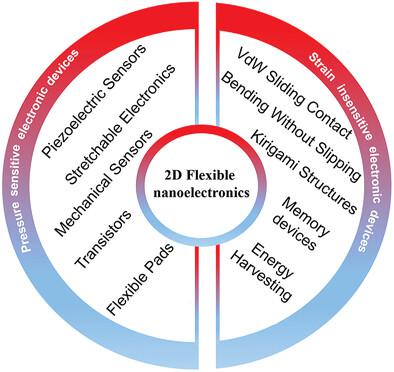当前位置:
X-MOL 学术
›
Adv. Mater.
›
论文详情
Our official English website, www.x-mol.net, welcomes your
feedback! (Note: you will need to create a separate account there.)
Latest Innovations in 2D Flexible Nanoelectronics
Advanced Materials ( IF 27.4 ) Pub Date : 2023-04-27 , DOI: 10.1002/adma.202301280 Sikandar Aftab 1 , Sajjad Hussain 2 , Abdullah A Al-Kahtani 3
Advanced Materials ( IF 27.4 ) Pub Date : 2023-04-27 , DOI: 10.1002/adma.202301280 Sikandar Aftab 1 , Sajjad Hussain 2 , Abdullah A Al-Kahtani 3
Affiliation

|
2D materials with dangling-bond-free surfaces and atomically thin layers have been shown to be capable of being incorporated into flexible electronic devices. The electronic and optical properties of 2D materials can be tuned or controlled in other ways by using the intriguing strain engineering method. The latest and encouraging techniques in regard to creating flexible 2D nanoelectronics are condensed in this review. These techniques have the potential to be used in a wider range of applications in the near and long term. It is possible to use ultrathin 2D materials (graphene, BP, WTe2, VSe2 etc.) and 2D transition metal dichalcogenides (2D TMDs) in order to enable the electrical behavior of the devices to be studied. A category of materials is produced on smaller scales by exfoliating bulk materials, whereas chemical vapor deposition (CVD) and epitaxial growth are employed on larger scales. This overview highlights two distinct requirements, which include from a single semiconductor or with van der Waals heterostructures of various nanomaterials. They include where strain must be avoided and where it is required, such as solutions to produce strain-insensitive devices, and such as pressure-sensitive outcomes, respectively. Finally, points-of-view about the current difficulties and possibilities in regard to using 2D materials in flexible electronics are provided.
中文翻译:

二维柔性纳米电子学的最新创新
具有无悬挂键表面和原子薄层的二维材料已被证明能够融入柔性电子设备中。二维材料的电子和光学特性可以通过使用有趣的应变工程方法以其他方式调整或控制。本综述浓缩了有关创建柔性二维纳米电子学的最新且令人鼓舞的技术。这些技术有可能在短期和长期内得到更广泛的应用。可以使用超薄二维材料(石墨烯、BP、WTe 2、VSe 2等)和二维过渡金属二硫族化物(2D TMD)来研究器件的电学行为。一类材料是通过剥离散装材料在较小规模上生产的,而化学气相沉积(CVD)和外延生长则在较大规模上采用。本概述强调了两个不同的要求,其中包括单一半导体或各种纳米材料的范德华异质结构。它们分别包括必须避免应变的地方和需要应变的地方,例如生产应变不敏感设备的解决方案,以及压力敏感结果。最后,提供了有关当前在柔性电子产品中使用二维材料的困难和可能性的观点。
更新日期:2023-04-27
中文翻译:

二维柔性纳米电子学的最新创新
具有无悬挂键表面和原子薄层的二维材料已被证明能够融入柔性电子设备中。二维材料的电子和光学特性可以通过使用有趣的应变工程方法以其他方式调整或控制。本综述浓缩了有关创建柔性二维纳米电子学的最新且令人鼓舞的技术。这些技术有可能在短期和长期内得到更广泛的应用。可以使用超薄二维材料(石墨烯、BP、WTe 2、VSe 2等)和二维过渡金属二硫族化物(2D TMD)来研究器件的电学行为。一类材料是通过剥离散装材料在较小规模上生产的,而化学气相沉积(CVD)和外延生长则在较大规模上采用。本概述强调了两个不同的要求,其中包括单一半导体或各种纳米材料的范德华异质结构。它们分别包括必须避免应变的地方和需要应变的地方,例如生产应变不敏感设备的解决方案,以及压力敏感结果。最后,提供了有关当前在柔性电子产品中使用二维材料的困难和可能性的观点。

















































 京公网安备 11010802027423号
京公网安备 11010802027423号